DENTAL IMPLANTS

Dental implants are designed to provide a foundation for replacement teeth that look, feel and function like natural teeth. The person who has lost teeth regains the ability to eat virtually anything and can smile with confidence, knowing that teeth appear natural and that facial contours will be preserved. The implants are tiny titanium posts which are placed into the jaw bone where teeth are missing. The bone bonds with the titanium, creating a strong foundation for artificial teeth. In addition, dental implants can help preserve facial structure, preventing the bone deterioration which occurs when teeth are missing.
Dental implants are changing the way people live! With them, people are rediscovering the comfort and confidence to eat, speak, laugh and enjoy life.
DENTAL IMPLANT PROCEDURE
Dental implants are metal anchors, which act as tooth root substitutes. They are surgically placed into the jaw bone. Small posts are then attached to the implant, which protrude through the gums. These posts provide stable anchors for artificial replacement teeth.
For most patients, the placement of dental implants involves two surgical procedures. First, dental implants are placed within your jaw bone. For the first three to six months following surgery, the implants are beneath the surface of the gums, gradually bonding with the jaw bone. You should be able to wear temporary dentures and eat a soft diet during this time. At the same time, your restorative dentist designs the final bridgework or denture, which will ultimately improve both function and aesthetics.
After the dental implant has bonded to the jaw bone, the second phase begins. When will uncover the implants and attach a small healing collar. Dr. Gaspar can then start making your new teeth. An impression must be taken. Then posts or attachments can be connected to the implants. The replacement teeth are then made over the posts or attachments. The entire procedure usually takes six to seven months. Most patients do not experience any disruption in their daily life.
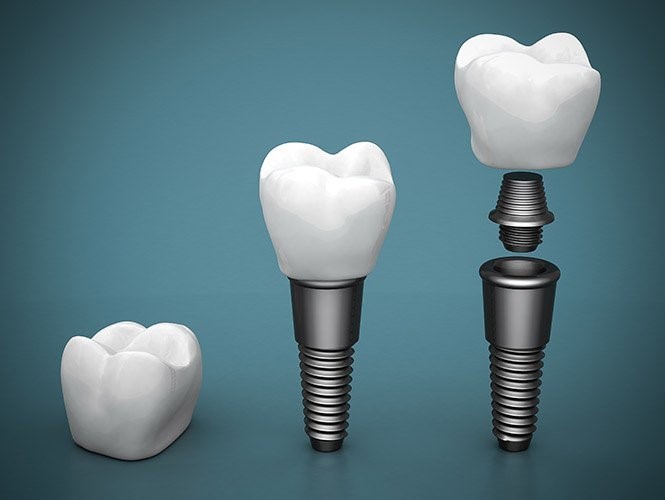
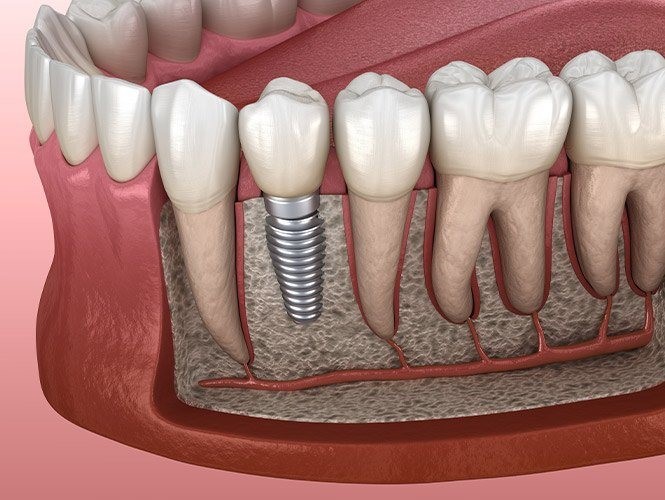
BENEFITS OF DENTAL IMPLANTS
Dental implants are very different from traditional bridges and dentures that just sit on top of the gums. Instead, Dr. Rasmussen places small titanium posts into the jawbone that act as artificial tooth roots, and these are used to support the new teeth. This approach brings with it a host of advantages:
- Self-Stabilizing: Implanted teeth sit within strong jawbone just like real ones, enabling a patient to eat whatever they like without having to deal with slippage or breakage.
- Aesthetically Pleasing: Every implant post is topped with a 100% custom-made restoration, and because implants don’t require unnatural-looking attachments to stay in place, this gives them a lifelike appearance that blends into anyone’s smile.
- Bone Preservation: The jawbone tends to atrophy after tooth loss, but implants can help stimulate the bone and lead to the growth of new tissue right where it’s needed. This ensures the remaining teeth stay strong and the facial muscles always have adequate support (which can prevent the formation of wrinkles).

INDICATIONS FOR DENTAL IMPLANTS
In order to be a good candidate for dental implants, a patient needs decent oral health and a jawbone strong enough to support the new roots. Once he determines that a patient’s mouth is in good enough shape to safely receive implants, he can place the posts, which can be paired with a variety of restorations depending on a patient’s needs:
Missing One Tooth
A single implant can be placed into the jawbone between two healthy teeth and topped with a porcelain crown without disturbing the nearby dental structure at all. This is much less invasive compared to a bridge, in which the neighboring teeth have to be filed down to support the prosthetic.
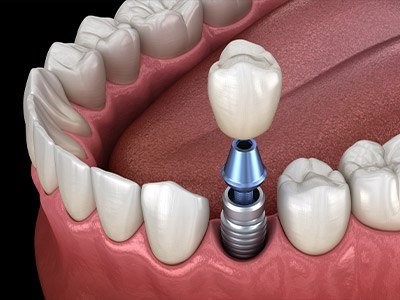
Missing Multiple Teeth
For consecutive missing teeth or those located throughout the mouth, implants can also serve as the foundation for a bridge or partial denture. This gives the prosthetics a strength and security removable ones simply can’t match.
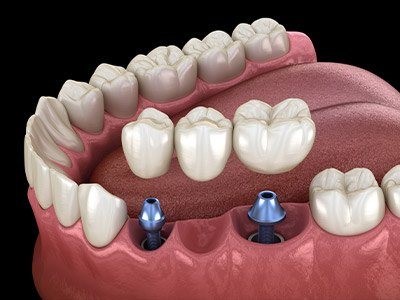
Missing All Teeth
Even people missing all of their teeth along a single row can benefit from implant dentistry. Using a small number of implant roots, a full denture can be anchored to the jawbone that looks better, provides a stronger bite, and lasts longer than any traditional one.
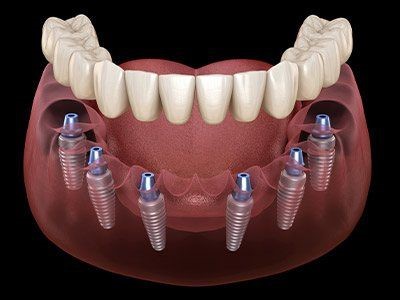
Missing One Tooth
A single implant can be placed into the jawbone between two healthy teeth and topped with a porcelain crown without disturbing the nearby dental structure at all. This is much less invasive compared to a bridge, in which the neighboring teeth have to be filed down to support the prosthetic.
Missing Multiple Teeth
For consecutive missing teeth or those located throughout the mouth, implants can also serve as the foundation for a bridge or partial denture. This gives the prosthetics a strength and security removable ones simply can’t match.
Missing All Teeth
Even people missing all of their teeth along a single row can benefit from implant dentistry. Using a small number of implant roots, a full denture can be anchored to the jawbone that looks better, provides a stronger bite, and lasts longer than any traditional one.



